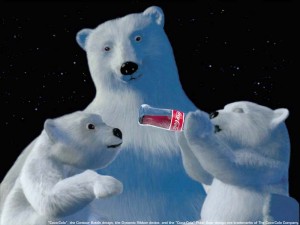Coca Cola has been using polar bears as its brand mascot since 1922, when it first appeared alongside the company’s logo on a French print ad. From then on, polar bears have become the official mascot of the company during the winter season, especially during the holiday season alongside Santa Claus. The article explains briefly that consumers tend to disassociate brand mascots from the real wild animals if the mascots are more anthropomorphized (Frazier).
In the case of Coca-Cola, its brand mascot has started to be frequently associated with climate change and how that has affected polar bears. The writer of the article also notes that under the current environmental circumstances, Coca-Cola and many other companies that employ animals as mascots have contributed certain amount of money to charities that benefit these animals (Frazier).
As a brand valued higher than many countries’ GDPs, marketing expenses usually go towards keeping brand awareness constant within it’s large consumer base. The coke product of the Coca-Cola Company has possibly saturated the market for carbonated drinks to its fullest extent. Therefore, most of its strategic decisions for the specific product are for the purposes of extending its product life cycle. Additionally, the polar bear is a small fraction of Coca-Cola’s advertising campaign done nationally and internationally. For example, we may have seen the videos of people hugging Coca-Cola vending machines for free cola. Thus, if Coca-Cola is under fire for spending minimally on improving the living environment of polar bears, should they adopt the cuddly white bears as their mascot in their future? Is the association between them and polar bears unbreakable? I don’t believe so. Coca-Cola has become a household product staple enough to be profitable without any advertising campaign, even in midst of all the criticism and research towards its adverse effects on human health.
(Google Images)
Coca-Cola and many other brands that use animals as mascots have been possibly publically pushed into spending capital on charities associated with their mascots. When the brand is a household brand (such as Coca-Cola and Kellogg’s) they could be responsible for taking the consumers’ mind off of the troubling situations that the wild animals face in reality. As the article explained, the mascots look less like their wild, real counterparts and leave a more cartoonish, fictional impression on the consumers. This impression is not an incentive for consumers to care about the wild animals. I believe that the companies’ contribution to charity is a compensation for the effect they have on their consumers’ perspectives regarding the state of the wild animals.
Works Cited List
Frazier, Mya. “Should the Polar Bear Still Sell Coca-Cola?” The New Yorker. The New Yorker, 06 Nov. 2014. Web. 06 Nov. 2014.
